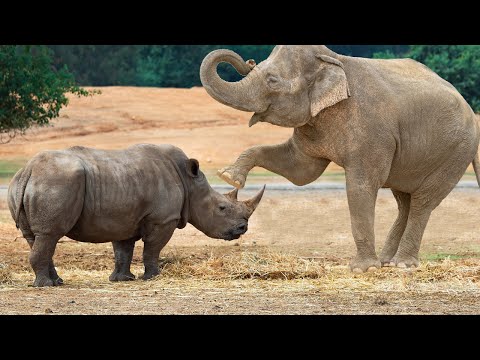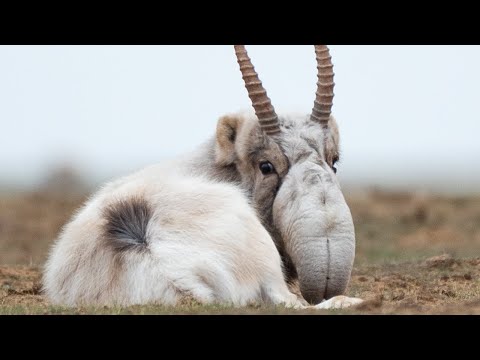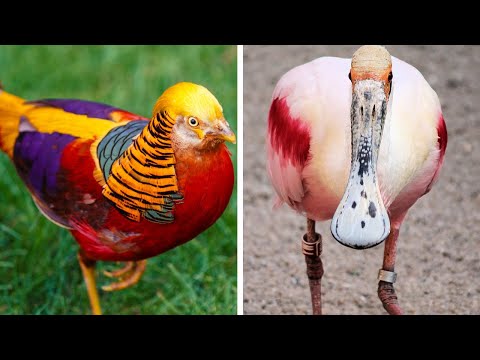Birds You’ve Probably Never Heard Of
expand_morethumb_upLike
thumb_downDislike
sendShare
library_addSave
flagReport
Secret Truths check_circle
1K subscribers
Strangest birds on earth! These are some of the more unusual birds in the world that you may not have ever heard of
Subscribe for more videos: http://bit.ly/2vW6JVo
Number 8 - Golden Pheasant
Also called the rainbow pheasant, this bird is recognized for its golden crest, rump, and crimson body. The golden pheasant is also adorned with deep blue tertiary feathers that contrast its otherwise warm color scheme. The female pheasants aren't as bright, with dull brown feathers darker than those of a female common pheasant. Adult male golden pheasants reach up to 41 inches long, with the tail making up about two-thirds of its length, and the females only grow to 31 inches with a much shorter tail. Although these birds can fly, they don't do so very well; so, golden pheasants spend most of their time running around on the ground, only roosting in the trees at night.
Number 7 - Greater Rhea
This large flightless bird is found in South America, and its name, "Rhea ," comes from the Greek goddess of the same title - the daughter of Gaia and Uranus . Adult greater rheas weigh up to 60 pounds and can measure 55 inches from their beaks to their tails. They stand up to an impressive 5 feet 7 inches, easily the size of a person. They have long legs, and their heads and bills are somewhat small. Although they're flightless, greater rheas use their wings to maintain balance while running and to attract females. Their colors are generally dull brown and gray, their plumage is shabby, and the females are lighter in hue than the males. However, some individuals exhibit white plumage and blue eyes from a condition called leucism , and some albino greater rheas aren't unheard of either. Rheas primarily eat the seeds and fruits of broad-leaved foliage but will consume rodents, reptiles, insects, small birds, and scorpions as well. Like other bird species, the greater rhea eats pebbles to assist with digestion and because of this, it is attracted to shiny objects. During the breeding season, male rheas put on displays and mate with females. They lead the female to their nests, where they lay their eggs. Once she lays her eggs with one male, she moves on and continues mating. The males of the species assume all of the incubation duties. Since the females continue mating with various males, each nest can end up containing up to 80 eggs.
Number 6 - Vulturine Guineafowl
Another strange-looking bird is the vulturine guineafowl . This large round-bodied bird has a small head, longer legs and wings, and longer necks and tails compared to most guineafowl. But, other than its odd proportions, this bird is unique because of its colors. Although featherless, the vulturine guineafowl's neck and head are blue and black. From the lower neck downward, shiny blue and white feathers protrude like a spiky scarf, and its breast area is ocean blue. The remainder of the bird's body is black with white spots. The vulturine guineafowl roosts in trees but is mostly terrestrial, spending much of its time walking or running.
Number 5 - Roseate Spoonbill
It is a wading bird found primarily in South America east of the Andes Mountains but also in Central America, the Caribbean, Mexico, and some coastal parts of the US. The roseate spoonbill reaches 34 inches long, has a 52-inch wingspan, and weighs up to about 4 pounds. Its bill grows up to just over 7 inches long. Unlike some of the other birds on this list, the females and males look generally the same. The reason the roseate spoonbill is pink is due to its diet, made up of newts, aquatic insects, frogs, small fish, and crustaceans - which contain the pigments that present themselves throughout the feathers. The spoon-like shape of its bill is what allows it to sift through the mud to find these insignificant prey.
1
vid:168478
Comments0
unfold_more






